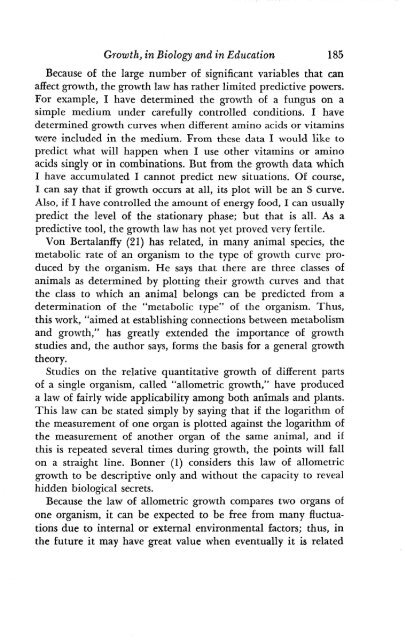Scientism and Values.pdf - Ludwig von Mises Institute
Scientism and Values.pdf - Ludwig von Mises Institute
Scientism and Values.pdf - Ludwig von Mises Institute
Create successful ePaper yourself
Turn your PDF publications into a flip-book with our unique Google optimized e-Paper software.
Growth} in Biology <strong>and</strong> in Education 185<br />
Because of the large number of significant variables that can<br />
affect growth, the growth law has rather limited predictive powers.<br />
For example, I have determined the growth of a fungus on a<br />
simple medium under carefully controlled conditions. I have<br />
determined growth curves when different amino acids or vitamins<br />
were included in the medium. From these data I would like to<br />
predict what will happen when I use other vitamins or amino<br />
acids singly or in combinations. But from the growth data which<br />
I have accumulated I cannot predict new situations. Of course,<br />
I can say that if growth occurs at all, its plot will be an S curve.<br />
Also, if I have controlled the amount of energy food, I can usually<br />
predict the level of the stationary phase; but that is all. As a<br />
predictive tool, the growth law has not yet proved very fertile.<br />
Von Bertalanffy (21) has related, in many animal species, the<br />
metabolic rate of an organism to the type of growth curve produced<br />
by the organism. He says that there are three classes of<br />
animals as determined by plotting their growth curves <strong>and</strong> that<br />
the class to which an animal belongs can be predicted from a<br />
determination of the "metabolic type" of the organism. Thus,<br />
this work, "aimed at establishing connections between metabolism<br />
arid growth," has greatly extended the importance of growth<br />
studies <strong>and</strong>, the author says, forms the basis for a gener.al growth<br />
theory.<br />
Studies on the relative quantitative growth of different parts<br />
of a single organism, called "allometric growth," have produced<br />
a law of fairly wide applicability among both animals <strong>and</strong> plants.<br />
This law can be stated simply by saying that if the logarithm of<br />
the measurement of one organ is, plotted against the logarithm of<br />
the measurement of another organ of the same animal, <strong>and</strong> if<br />
this is repeated several times during growth, the points will fall<br />
on a straight line. Bonner (I) considers this law of allometric<br />
growth to be descriptive only <strong>and</strong> without the capacity to reveal<br />
hidden biological secrets.<br />
Because the law of allometric growth compares two organs of<br />
one organism, it can be expected to be free from many fluctuations<br />
due to internal or external environmental factors; thus, in<br />
the future it may have great value when eventually it is related
















